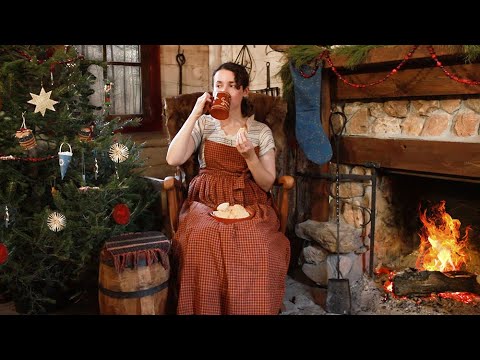What year is it again? Well, today’s it’s 1796 as we recreate this recipe for New Year’s Cakes. This recipe is from over 220 years ago. These cakes, which were cooked flat and small like modern day cookies, were intended to be handed out to guests during large New Year’s parties. Maybe try them at home and see what you think!
Our 2nd Channel! https://www.youtube.com/@frontierpatriot
Follow me on Instagram? https://www.instagram.com/justineybeanie/
How about Facebook? facebook.com/profile.php?id=100094684921749
Related eBooks


In Ste. Genevieve, Missouri every new year’s eve men and women of the town dress up in funny disguises and go from door to door dancing in a large circle while singing in PawPaw French (Missouri French). This is called La Guiannée. Home/Shop owners would have traditionally given the singer’s cakes, lard, butter, eggs, meat and candles before sending them on their way to the next house. Though every region’s New Year’s traditions are different, these small cakes are exactly the sort of thing that I imagine would have been given out at La Guiannée. Nowadays the gifts comprise more so of alcohol. This is a translation of the song that is sung at La Guiannée. La Guiannée is only practiced in 2 U.S. towns. Ste. Genevive and Prairie du Rocher, which is across the river from us. This has been a practice here since the early 1700s. I believe that this tradition can be traced back to Medieval France. This area was once French, with a visitor in the early 1800s noting that no one in Ste. Genevieve spoke English at all! Beginning in the 20th century English was forcibly taught in schools, with students being punished if they were caught speaking or writing in French. After many years of this now only a few still speak PawPaw French. Still, the area has clung onto a lot of it’s unique French-American traditions including La Guiannée. The celebration begins in the early evening and ends just after Midnight.
Good evening master and mistress,
And all who live with you.
For the first day of the year,
You owe us La Guignolée.
If you have nothing to give,
A chine of meat or so will do.
A chine of meat is not a big thing,
Only ninety feet long.
Again, we don’t ask for very much,
Only the oldest daughter of the house.
We will give her lots of good cheer,
And we will surely warm her feet.
Now, we greet you,
And beg you to forgive us please.
If we have acted a little crazy,
We meant it in good fun.
Another time we’ll surely be careful
To know when we must come back here again.
Let us dance La Guenille,
— La Guenille, La Guenille!
Any goods collected during La Guiannée were saved up for the Epiphany Feast. Following the feast, the community comes together to transition from the winter festivities to the spring celebrations. This transition occurs with the Kings Ball. At the King’s Ball we all get dressed up in 18th century clothing and dance to more PawPaw French. Depending on the year it can either be the King’s Ball or the Queen’s Ball. This year it is the Queen’s Ball, meaning that all of the ladies in the room are given a slice of cake. If your piece has a bean in it you are crowned the Queen of the year (bragging rights!) If you’re ever in the area consider taking part in our town’s fun festivities!
The following image will show you where PawPaw French is spoken in the United States. Anyone out there who is interested in learning endangered languages please consider picking this one up. PawPaw french is named after the American PawPaw tree. The language is unique and may not be understandable to a French speaker from France.
https://upload.wikimedia.org/wikipedia/commons/thumb/1/19/Missouri_French_Distribution.svg/1024px-Missouri_French_Distribution.svg.png
New Year’s Cakes (American Cookery, 1796. Second edition)
These measurements have been broken down from what was originally 14 pounds of flour and 5 pounds of sugar😬. Because of this, please pardon the wonky measurements. This quantity is much more realistic for a common household.
7 cups of flour
1.85 cups of sugar (just under 2 cups of sugar)
0.6 cups of yeast, in water
0.4 cups of warm milk
1.25 cups of softened butter
2 tablespoons of Caraway seeds
1 egg, well beaten
Combine flour, milk and yeast liquid. Let rise for 1 hour if using active dry yeast. If you are using homemade sourdough yeast you may need to keep a careful eye on it and let it rise over several hours. Cream the sugar and butter together In a separate bowl. Once the yeast has done it’s magic in your flour (you’ll know because when you go to poke it it will feel soft and spongy) add in an egg and caraway seeds. Mix carefully until you’ve formed a thick dough. Roll it out and cut it however you wish. Once cut out allow it to sit for an hour before baking at 350 degrees for 20 minutes. Allow to rest for at least 10 minutes before moving.
Hello…can you please explain the yeast? I’ve always opted the dry yeast but this looked different.
Yours better then mine…..My rule to making most anything, it has to have butter in it and or on it.
I just baked something like that. How funny.
It looks like a seed cake in cookie form
Hoping you, Ron, Mish Mish, the chickens and whoever I missed, have a happy new year!!!!
Best to you in 2024. Thanks for making great videos. ❤